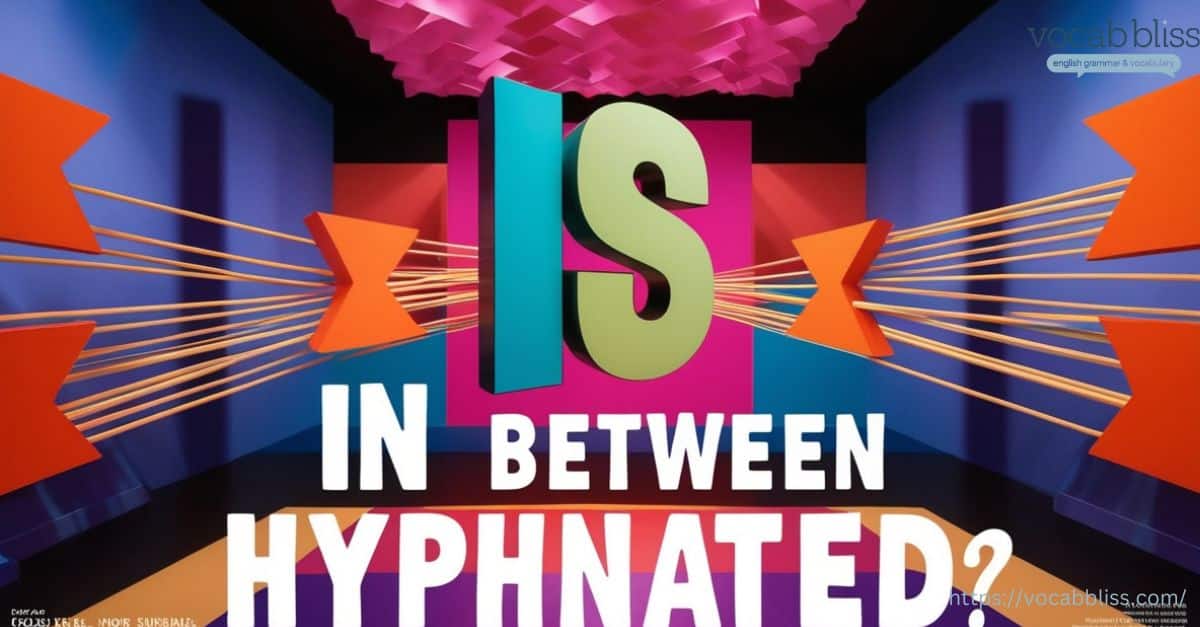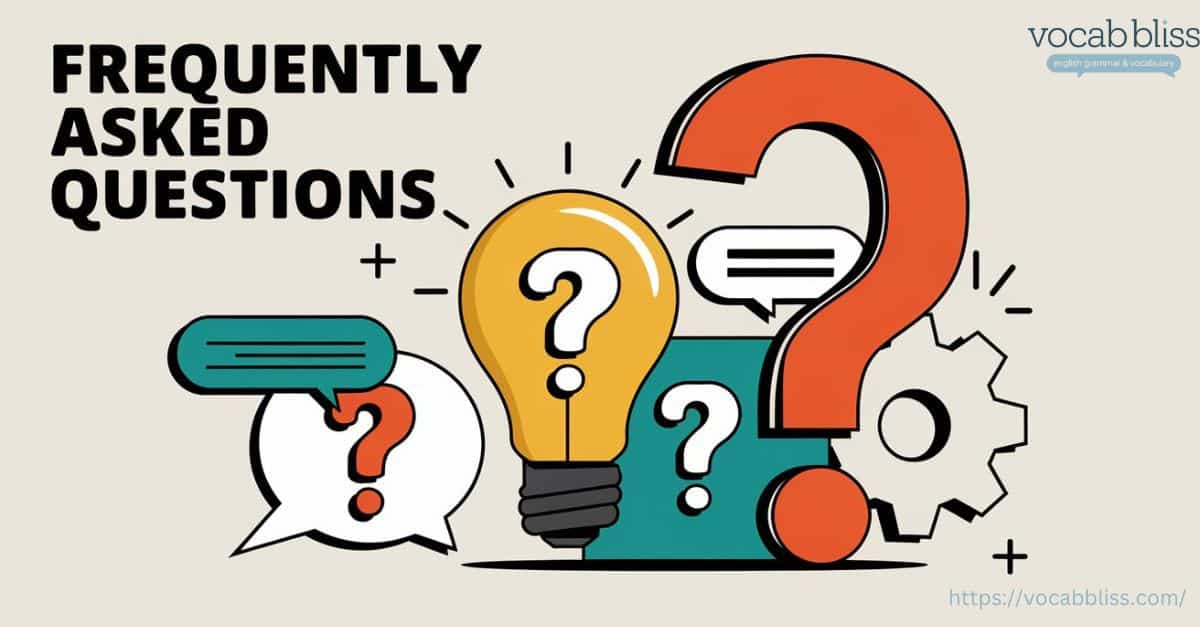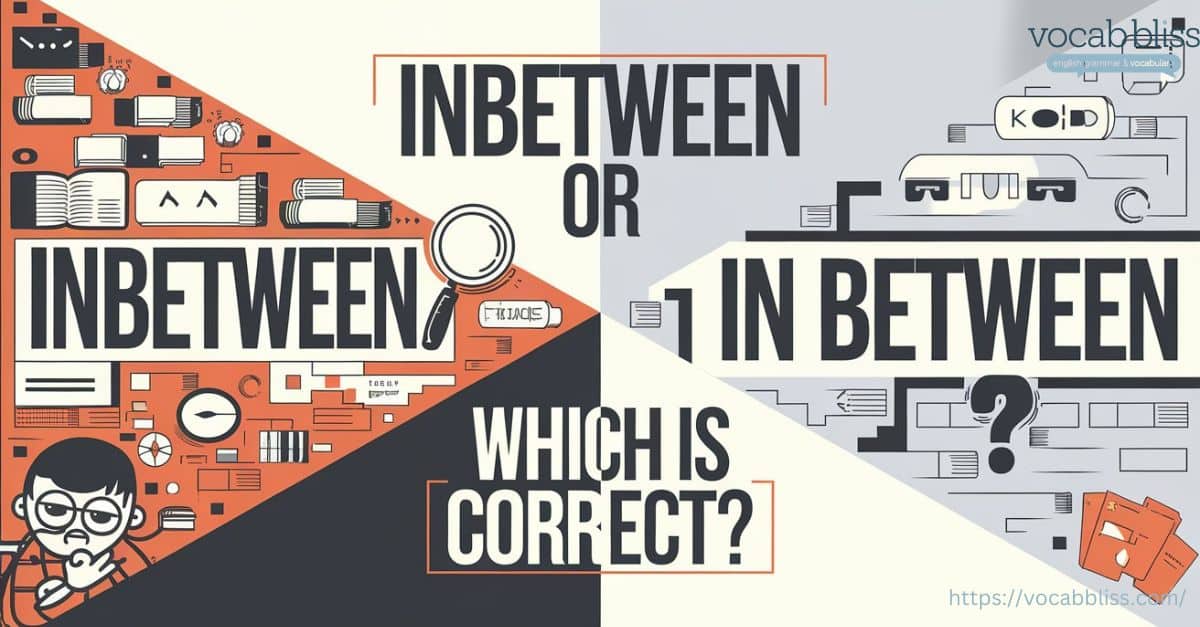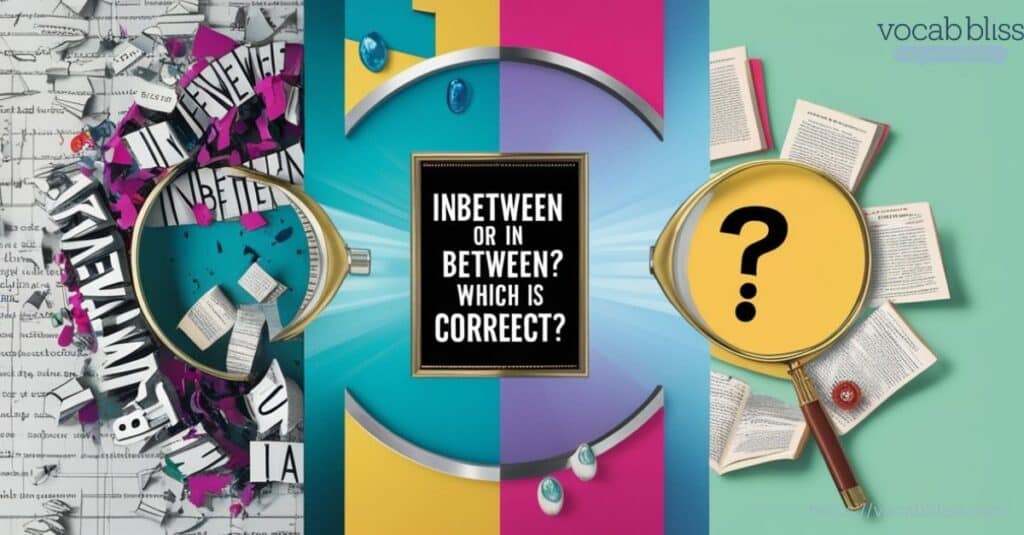When writing in English, it’s common to encounter the terms “inbetween or in between.” But are both correct? If not, which one should you use? In this article, we’ll clarify the differences, delve deeper into their usage, and ultimately help you confidently choose the right form for any context.
Understanding “Inbetween or In Between”
What Does “Inbetween” Mean?
The term “inbetween” is frequently encountered in informal contexts, but it is widely considered a misspelling or nonstandard usage in English. Most dictionaries, including Merriam-Webster and Oxford, do not recognize “inbetween” as a legitimate word. Instead, they list “in between” as the correct form.
Why Does “Inbetween” Appear in Writing?
- Informal Writing: Some people use “inbetween” as a shortcut, merging the two words for convenience.
- Typographical Errors: Mistakes like “inbetween” often result from fast typing or lack of awareness of proper spelling.
- Creative Usage: In literature or pop culture, “inbetween” might occasionally be used for stylistic purposes. For instance, “The Inbetweeners,” a popular TV show title, intentionally uses this nonstandard form to represent a transitional or undefined phase in life.
Key Insight: While “inbetween” may serve specific creative or informal purposes, on the other hand, it lacks acceptance in Standard English. As a result, it should be avoided in professional or academic writing.
Discover more: Skillset or Skill Set, Skill-Set,: Which is Right?
Breaking Down “In Between”
The phrase “in between” is not only a grammatically correct but also a widely used term in English. Moreover, it functions either as a prepositional phrase or an adverb, depending on the sentence structure.
Grammatical Role of “In Between”
- As a Preposition: “In between” is used to describe the position of something relative to two or more objects.
- As an Adverb: It can describe a state or condition that exists midway or in transition.
Meaning of “In Between”
The phrase “in between” refers to:
- Physical Placement: Being situated in the middle of two or more objects or points.
- Example: The bench is in between the two trees.
- Figurative Contexts: Referring to a transitional or intermediate state.
- Example: She feels in between jobs, unsure of her next step.
Proper Usage in Sentences
Here are examples of how “in between” is used correctly:
- The park is located in between the river and the highway. (Preposition)
- He feels caught in between his parents’ arguments. (Adverb)
- During the move, we stayed at a motel in between our old house and the new one.

Pro Tip: Always write “in between” as two separate words unless using it as a compound adjective like “in-between.” This ensures grammatical accuracy and clarity in your writing.
Common Questions About Usage inbetween or in between
Is Inbetween One Word or Two?
The short answer is that inbetween is not a word in standard English. It is considered a misspelling or a nonstandard variation of the phrase “in between.”
Why the Confusion?
The confusion arises from:
- Merging of Words: Similar to valid compounds like “into” or “within,” however, people sometimes mistakenly combine “in” and “between” into one word. As a result, this leads to confusion about its correct usage. Therefore, it’s important to remember that “in” and “between” should remain two separate words..
- Informal Usage: In casual or creative contexts, “inbetween” may appear, but this does not make it correct.
- Lack of Clarity: Writers unfamiliar with grammatical rules may assume “inbetween” is a valid term due to its frequent (but incorrect) usage.
Dictionary Entries (or Lack Thereof)
Major dictionaries, such as Oxford English Dictionary and Merriam-Webster, do not list “inbetween” as an acceptable word. Instead, they define “in between” as the correct form.
Key Fact: If you’re writing professionally or academically, always use “in between” as two separate words.
is in between hyphenated?

The hyphenated form, “in-between,” is correct only when used as a compound adjective to describe a noun. as a prepositional phrase or adverb, no hyphen is needed.
When to Use “In Between” Without a Hyphen
- When it functions as a prepositional phrase or adverb, write it as two separate words:
- The office is in between the gym and the café. (Prepositional phrase)
- He found himself stuck in between choices. (Adverb)
When to Use “In-Between” with a Hyphen
- Use the hyphenated form when “in-between” acts as a compound adjective modifying a noun:
- She’s going through an in-between phase in her career.
- The project is at an in-between stage of completion.
Examples for Comparison
| Sentence | Correct Form | Explanation |
|---|---|---|
| The keys are in between the cushions. | In between | Prepositional phrase, no hyphen needed. |
| This is an in-between solution. | In-between | Compound adjective modifying “solution.” |
Pro Tip: When in doubt, avoid hyphenation unless “in-between” directly describes a noun. For general positioning or state descriptions, stick with “in between.”
“Inbetween or In-Between or In Between”
Understanding the distinctions between “inbetween or in between or in-between” is crucial for clear and professional writing. While these forms may look similar, their meanings, usage, and appropriateness in different contexts vary significantly.
Comparing the Three Variations
| Variation | Meaning | Formality | Appropriateness |
|---|---|---|---|
| Inbetween | A nonstandard or incorrect variation of “in between.” | Informal/Incorrect | Avoid in formal writing; may appear in creative or casual contexts. |
| In-between | A hyphenated compound adjective used to describe a transitional state. | Semi-formal/Contextual | Appropriate when describing a noun, e.g., “an in-between stage.” |
| In between | The standard prepositional phrase or adverb indicating position or state. | Formal/Correct | Always correct in professional, academic, or general usage. |
Key Differences in Usage
Inbetween
- Common Error: Writers mistakenly use “inbetween” as a single word, assuming it is correct.
- Impact on Clarity: This form is likely to confuse readers or make writing appear unpolished. For example:
- Incorrect: The book fell inbetween the couch cushions.
- Correct: The book fell in between the couch cushions.
In-Between
- Proper Usage: Use the hyphenated form when functioning as an adjective to describe a noun:
- She’s at an in-between point in her life.
- Common Error: Overusing the hyphenated form, even when it’s unnecessary, such as in prepositional phrases:
- Incorrect: The keys are in-between the cushions.
- Correct: The keys are in between the cushions.
In Between
- Proper Usage: Always write “in between” as two words when it functions as a prepositional phrase or adverb.
- Strength in Clarity: This form is universally recognized, grammatically correct, and easily understood.
Common Errors and Their Impact
- Using “Inbetween” in Formal Writing:
- Error: Submitting professional documents or essays with “inbetween” diminishes credibility.
- Impact: Readers may perceive the writer as careless or unskilled in grammar.
- Overusing “In-Between” as a Default Form:
- Error: Writing “in-between” in contexts where hyphenation is unnecessary.
- Impact: Over-hyphenation distracts readers and complicates otherwise simple sentences.
- Interchanging “In Between” and “Between” Without Context:
- Error: Replacing “in between” with “between” without recognizing subtle differences.
- Impact: This error changes the nuance of a sentence, potentially confusing the reader.
- Incorrect: She felt stuck between work and home.
- Correct: She felt stuck in between work and home.
Pro Tip for Writers

To avoid errors, remember these rules:
- Use “in between” for spatial, figurative, or transitional meanings.
- Reserve “in-between” for modifying a noun directly as a compound adjective.
- Avoid “inbetween” entirely unless you’re using it creatively in informal writing.
Side-by-Side Comparison Table inbetween or in between
| Aspect | Inbetween | In Between | In-Between |
|---|---|---|---|
| Grammar | Nonstandard | Prepositional phrase | Compound adjective |
| Formality | Informal only | Formal and informal | Formal when modifying nouns |
| Examples | She’s stuck inbetween. | The house is in between. | He’s in an in-between stage. |
Clear Recommendation for Writers
When in doubt, always choose “in between” in your writing. It is the only universally accepted form in Standard English for formal, academic, and even casual usage.
Pro Tip: Avoid using “inbetween” in professional contexts, as it can detract from your credibility.
Everyday Usage Examples
To solidify your understanding, let’s delve into some examples of both correct and incorrect usage. For instance, take note of the following examples:
Correct Usage:
- The keys are in between the cushions of the couch.
- It’s important to balance work and life, finding a middle ground in between.
- She’s in an awkward, in-between phase of her career.
Incorrect Usage:
- The keys are inbetween the cushions.
- It’s an inbetween solution.
Note:While informal and creative writing may sometimes feature “inbetween,” on the other hand, it’s better avoided in professional contexts. In fact, using the correct form, “in between,” ensures clarity and adherence to standard language rules.
Frequently Asked Questions

Is “inbetween” a real word?
No, “inbetween” is not recognized in formal English. Always use “in between.”
When should “in-between” be used?
Use the hyphenated form when describing a noun, such as an “in-between” moment.
Does it matter in creative writing?
While creative writing offers more flexibility, using nonstandard forms like “inbetween” can still confuse readers.
Can “in between” be used as an adjective?
No, use “in-between” as the adjective form.
Conclusion

The distinction between “inbetween or in between” lies in their correctness and usage. To clarify further, for clear and polished writing, always opt for “in between.” This is because the phrase is grammatically sound, universally recognized, and suitable for all contexts. However, use “in-between” sparingly as an adjective, and most importantly, avoid “inbetween” in formal communication.
Continue reading:
- Kart vs Cart: Appropriate Use and Context
- Ballon or Balloon: Solving the Spelling Issue
- High Quality or High-Quality: Which One Should You Use?
- Is It Fourty or Forty? Which One Is Accurate?

Jorge Phillips is an experienced blogger who writes for Vocab Bliss, sharing his passion for the English language. With a knack for simplifying complex grammar rules and a focus on commonly confused words, Jorge helps readers navigate the nuances of English with ease. His insights aim to make learning engaging and practical.







